The Philippines archipelago, comprised of over 7,600 islands, is nestled within the Coral Triangle—the global epicenter of marine biodiversity. With its crystal-clear waters, vibrant coral reefs, and unique underwater ecosystems, the Philippines offers some of the most spectacular diving experiences in the world. Marine biologists and diving enthusiasts alike recognize these waters as a living laboratory, hosting approximately 2,000 fish species and over 500 coral species. This underwater paradise presents opportunities to encounter creatures ranging from the microscopic to the massive, from the common to the critically endangered. Whether you’re a seasoned diver or planning your first underwater adventure, here’s a guide to 15 amazing creatures you might encounter while diving in the Philippine waters.
The Magnificent Thresher Shark

Malapascua Island in the central Philippines has gained international fame as one of the few places on Earth where divers can reliably encounter thresher sharks (Alopias pelagicus). These remarkable creatures are instantly recognizable by their extraordinarily long, scythe-like tail fins, which can constitute nearly half of their total body length of up to 20 feet. Unlike many shark species that inspire fear, threshers are typically shy and non-aggressive toward humans, preferring to keep their distance from divers.
What makes the thresher shark truly fascinating is its hunting technique. These predators use their elongated tails as weapons, stunning or even killing prey with powerful, whip-like movements that can reach speeds of up to 80 mph underwater. Dawn dives at Monad Shoal, a submerged island near Malapascua, offer the best chances to witness these elegant hunters as they visit cleaning stations where smaller fish remove parasites from their skin and gills. Conservation status is currently vulnerable, with populations declining due to fishing pressure and their low reproductive rate, making every encounter with these magnificent creatures truly special.
The Elusive Dugong
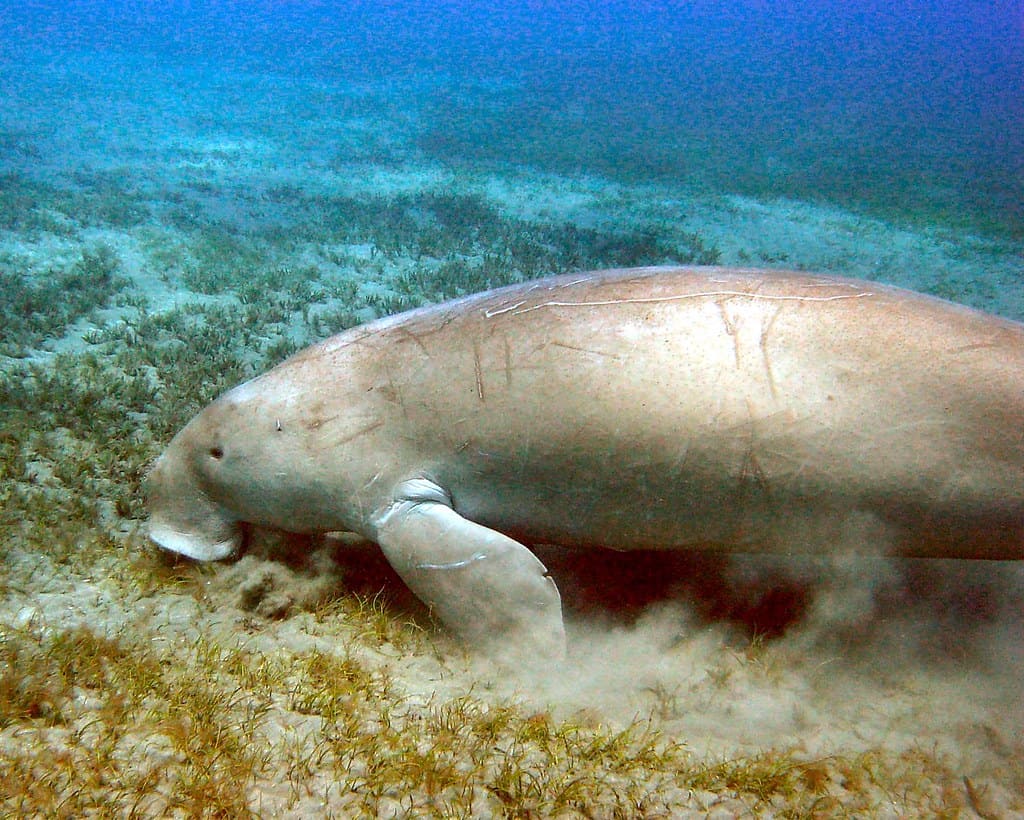
Often referred to as “sea cows,” dugongs (Dugong dugon) represent one of the most enchanting marine mammal encounters possible in Philippine waters. These gentle herbivores, closely related to manatees but distinguished by their dolphin-like fluked tails, can reach lengths of up to 10 feet and weigh over 800 pounds. They feed exclusively on seagrass, consuming up to 88 pounds daily, making them true gardeners of the ocean as they help maintain healthy seagrass ecosystems.
The best opportunities to spot these vulnerable creatures occur in the clear waters around Dimakya Island in northern Palawan and Calauit Island. Divers must exercise patience and maintain respectful distances, as dugongs are naturally wary and easily startled. Their populations have dramatically declined by an estimated 30% over the past 60 years due to habitat destruction, boat strikes, and hunting. Local conservation efforts, including the establishment of protected areas and community education programs, are working to ensure these charismatic marine mammals continue to grace Philippine waters for generations to come.
The Technicolor Mandarin Fish
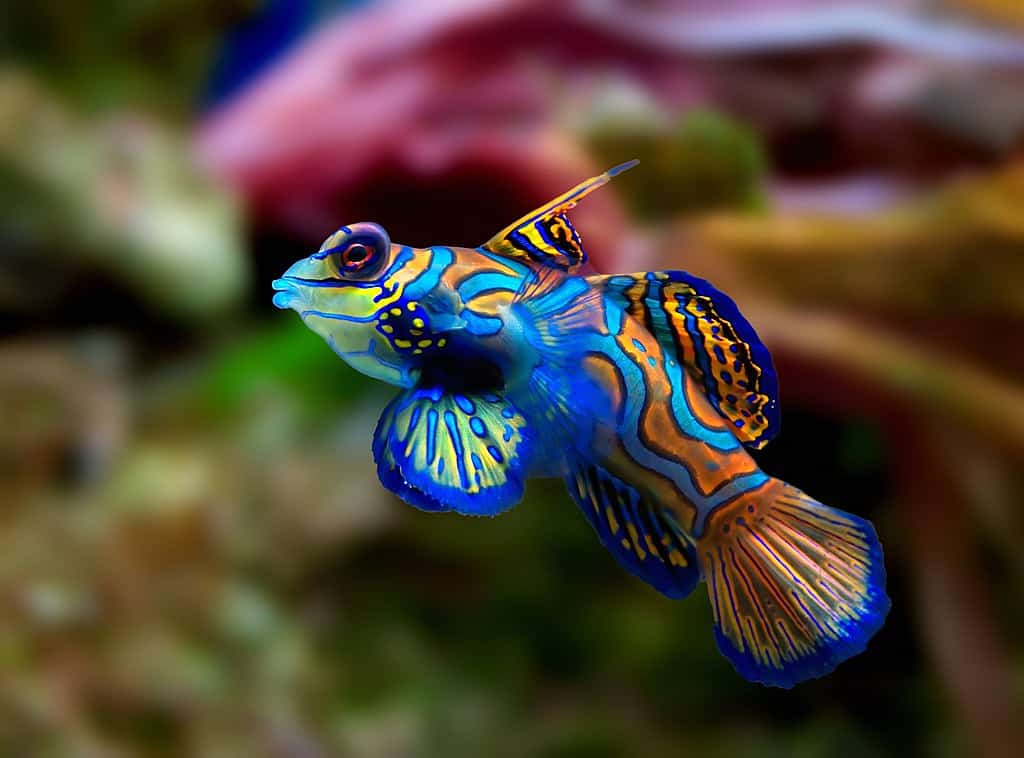
Among the most visually striking fish in the ocean, the mandarin fish (Synchiropus splendidus) is a living kaleidoscope of electric blue, vibrant orange, and green patterns. These small dragonets, rarely exceeding 3 inches in length, make their homes in protected lagoons and reef flats throughout the Philippines, with particularly reliable sightings at dive sites in Dauin, Negros Oriental, and around Puerto Galera. What makes these fish particularly remarkable is not just their appearance but also their immunity to predators—their flesh contains a toxic mucus that renders them unpalatable to most would-be hunters.
For divers hoping to witness one of nature’s most spectacular courtship displays, dusk dives offer opportunities to observe mandarin fish mating rituals. Just before sunset, males perform elaborate dances to attract females, eventually rising in pairs several inches above the reef in a synchronized spawning ascent that lasts just a few seconds. Photographers should note that these fish are extremely sensitive to light, so flash photography is discouraged as it disrupts their natural behaviors. Unlike many reef species that are threatened by climate change, mandarin fish populations remain relatively stable, though the aquarium trade poses localized threats in some areas.
The Mysterious Mimic Octopus

The mimic octopus (Thaumoctopus mimicus), discovered only in 1998, represents one of the most intelligent and behaviorally complex creatures divers might encounter in Philippine waters, particularly in the sandy bottom environments of Anilao and Dauin. This remarkable cephalopod has elevated mimicry to an art form, capable of impersonating at least 15 different marine species including sea snakes, lionfish, flatfish, and mantis shrimp. The octopus achieves these transformations not only by changing its coloration and texture but also by altering its body shape and movement patterns to replicate potentially dangerous creatures.
Growing to approximately two feet in length, the mimic octopus displays problem-solving abilities and adaptive behaviors that suggest a sophisticated intelligence. Divers hoping to spot this master of disguise should scan sandy areas adjacent to reefs, looking for characteristic burrows with discarded shells nearby. Patience is essential, as these creatures may remain hidden or disguised right before your eyes. While not currently listed as endangered, mimic octopuses face threats from habitat degradation and collection for the aquarium trade. Their short lifespan of approximately 9 months means that their populations can fluctuate rapidly, making each encounter with this shape-shifting wonder a rare privilege.
The Endangered Green Sea Turtle
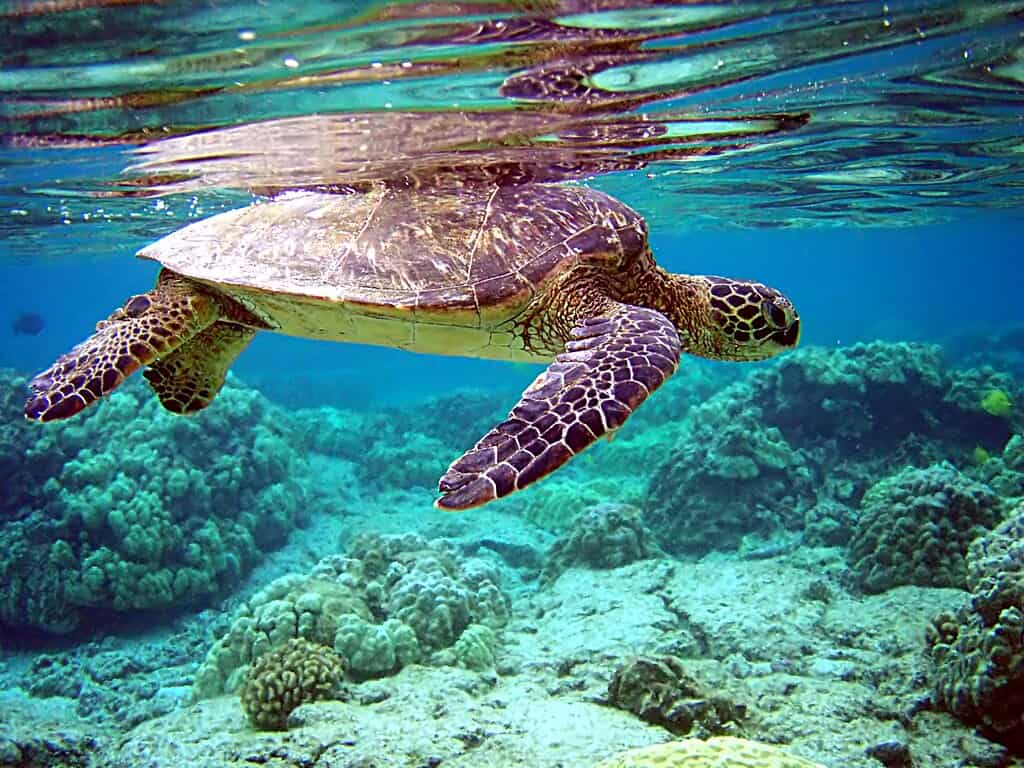
Green sea turtles (Chelonia mydas), despite their name, display carapaces ranging from olive to black rather than green—their name actually derives from the greenish color of their fat. These magnificent reptiles can live up to 80 years and grow to impressive dimensions, with adults typically measuring 3-4 feet in length and weighing between 300-350 pounds. The Philippines hosts several significant nesting and feeding grounds for these endangered creatures, with the Turtle Islands Wildlife Sanctuary in Tawi-Tawi serving as one of the most important nesting sites in Southeast Asia, where approximately 2,000 turtles come ashore annually.
For divers, encounters with green sea turtles are possible throughout Philippine waters, though Apo Island near Dumaguete and the Tubbataha Reefs Natural Park are particularly renowned for reliable sightings. These gentle reptiles play crucial ecological roles—adults are primarily herbivores that maintain healthy seagrass beds, while juveniles serve as important controllers of jellyfish populations. Critically endangered due to historical harvesting, ongoing habitat destruction, plastic pollution, and climate change, green sea turtles benefit from strict protection measures implemented throughout the Philippines. When encountering these ancient mariners underwater, divers should maintain a respectful distance of at least 10 feet and never touch or chase them, as stress can cause them to abandon feeding grounds.
The Bizarre Flamboyant Cuttlefish

The flamboyant cuttlefish (Metasepia pfefferi) defies conventional notions of cephalopod behavior and appearance. Unlike its relatives that rely on camouflage, this small cuttlefish—rarely exceeding 3 inches in length—advertises its presence with psychedelic displays of purple, yellow, red, and brown patterns rippling across its body. This audacious color show serves as a warning: the flamboyant cuttlefish produces toxic compounds in its muscle tissue that rank it among the few venomous cephalopods known to science, with toxicity comparable to that of the blue-ringed octopus.
Anilao in Batangas province and the black sand environments of Dauin provide prime opportunities to encounter these extraordinary creatures. Rather than swimming like typical cuttlefish, flamboyant cuttlefish often “walk” along the seafloor using specialized arms and fins in a manner reminiscent of a crawling infant. They exhibit remarkable intelligence, with brain-to-body ratios comparable to those of dolphins, and demonstrate complex hunting strategies despite their diminutive size. While not officially listed as endangered, their restricted range makes them vulnerable to habitat degradation. Divers should exercise extreme caution around these creatures—while fatal human envenomations haven’t been documented, their toxins warrant a respectful distance.
The Colossal Whale Shark

The whale shark (Rhincodon typus), the world’s largest fish, graces Philippine waters with remarkable reliability, particularly around Donsol Bay in Sorsogon and Oslob in Cebu. These gentle giants can reach astonishing dimensions, with the largest specimens measuring up to 40 feet in length and weighing over 20 tons. Despite their imposing size, whale sharks are filter feeders that pose no threat to humans, subsisting primarily on plankton, krill, and small fish. They filter approximately 1,500 gallons of water per hour through gill rakers that function like sophisticated sieves.
The Philippines has established itself as a global center for whale shark research and conservation, with scientific studies indicating that these waters serve as important developmental habitats for juvenile sharks. Each whale shark carries a unique pattern of spots on its skin—as distinct as a human fingerprint—allowing researchers to identify and track individuals throughout their lives. Currently listed as endangered with global populations declining by more than 50% over the past 75 years, whale sharks face threats from vessel strikes, accidental entanglement in fishing gear, and targeted hunting in some regions. While swimming or diving with these magnificent creatures offers an unforgettable experience, responsible interaction guidelines mandate maintaining distances of at least 13 feet from the body and 16 feet from the tail to ensure both human safety and minimal disturbance to the sharks.
The Deadly Blue-Ringed Octopus
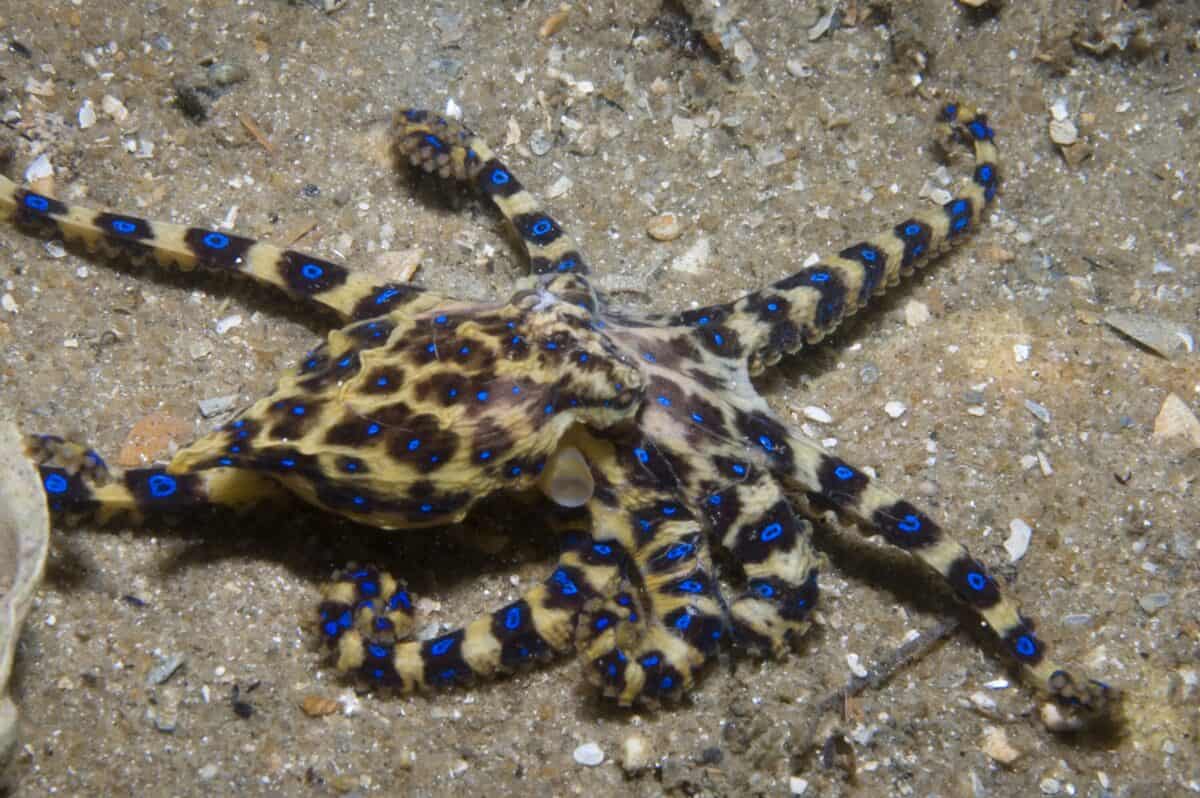
Among the most captivating yet dangerous creatures a diver might encounter in Philippine waters is the blue-ringed octopus (primarily Hapalochlaena lunulata in this region). These diminutive cephalopods rarely exceed 8 inches in total length, but their modest size belies their lethal potential—they carry enough tetrodotoxin to kill 26 adult humans within minutes, with no effective antivenom currently available. When threatened, these normally camouflaged octopuses display vibrant blue rings as a warning signal, creating one of the ocean’s most striking and unmistakable visual displays.
Divers may encounter blue-ringed octopuses in shallow, rocky reef environments throughout the Philippines, with notable populations around Anilao, Dauin, and Puerto Galera. These intelligent hunters are primarily nocturnal, emerging at dusk to prey on small crustaceans and fish. Despite their potent venom, blue-ringed octopuses are not aggressive toward humans and will only bite if handled or threatened. For underwater photographers, these creatures represent a prized but challenging subject—their rarity, small size, and the absolute necessity of maintaining a safe distance makes capturing images difficult. While not considered endangered, their specialized habitat requirements make them vulnerable to coastal development and pollution. The universal diver’s rule applies with particular importance here: look but never touch.
The Graceful Manta Ray

Few underwater encounters rival the majesty of swimming alongside a manta ray (Mobula birostris), with their massive wingspans reaching up to 23 feet and weights exceeding 3,000 pounds. These filter-feeding giants possess the largest brain-to-body ratio of any fish, displaying remarkable intelligence and curiosity toward divers. The Philippines offers several reliable locations to witness these magnificent creatures, with Ticao Pass near Donsol and Tubbataha Reefs Natural Park standing out as premier destinations. Recent research has revealed that individual mantas can be identified by the unique pattern of spots on their undersides, allowing scientists to track populations and movements.
What makes manta rays particularly fascinating is their feeding behavior—they perform graceful barrel rolls with mouths agape to filter plankton from the water, sometimes in coordinated groups that create stunning underwater ballets. Unlike their relatives, the stingrays, mantas possess no venomous barb and are completely harmless to humans. Currently listed as vulnerable with populations declining globally, these gentle giants face threats from targeted fishing for their gill rakers, which are used in some traditional medicine practices despite having no proven medicinal value. Various conservation initiatives in the Philippines aim to protect critical manta habitats, including the establishment of marine protected areas and the implementation of sustainable tourism practices that allow divers to appreciate these magnificent creatures without disturbing their natural behaviors.
The Cryptic Pygmy Seahorse
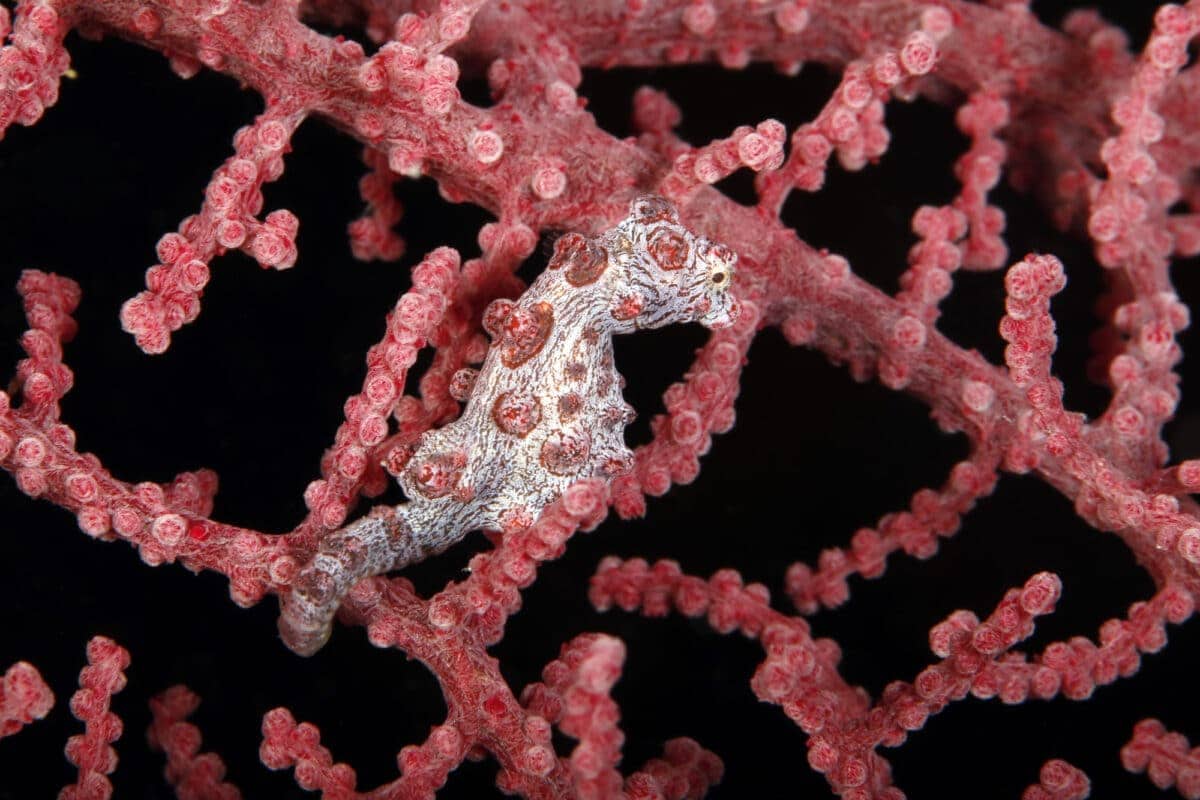
Among the ocean’s most extraordinary examples of camouflage, the pygmy seahorse (primarily Hippocampus bargibanti in Philippine waters) represents the ultimate challenge for underwater naturalists and photographers. These minuscule marvels, measuring just 0.6-0.8 inches in length—smaller than a grain of rice—live in perfect symbiosis with gorgonian sea fans, primarily of the genus Muricella. Their bodies have evolved to match their host corals with such precision that they remained undiscovered by science until 1970, despite sea fans being well-studied by marine biologists for centuries.
The best locations to search for these elusive creatures include the rich coral environments of Anilao, Puerto Galera, and Dauin, where dive guides with exceptional spotting skills can point them out to visitors. Pygmy seahorses display fascinating reproductive biology—like all seahorses, the males become pregnant, carrying up to 34 offspring in specialized brood pouches. Their tiny size makes them extremely vulnerable to environmental changes, particularly coral bleaching events that destroy their host habitats. While their conservation status remains officially “data deficient” due to the challenges of studying such cryptic species, local dive operators have implemented protocols to minimize disturbance, including restrictions on flash photography and limits on the number of divers who can view a single seahorse. For many underwater photographers, successfully capturing an image of these perfectly camouflaged masters of disguise represents the pinnacle of achievement.
The Venomous Lionfish

With their distinctive red and white striped pattern and fan-like array of venomous spines, lionfish (primarily Pterois volitans and Pterois miles) represent one of the most visually striking yet potentially dangerous reef dwellers in Philippine waters. These members of the scorpionfish family can reach sizes of up to 15 inches and are found throughout the archipelago’s coral reef ecosystems. Their elegant appearance masks their role as voracious predators—a single lionfish can reduce juvenile fish populations on a coral reef by up to 79% through their unique hunting strategy. They corral prey with their large pectoral fins before swallowing victims whole, sometimes consuming fish nearly half their own size.
For divers, lionfish present a fascinating but cautious encounter opportunity. Their venom, delivered through 18 needle-like dorsal, anal, and pelvic spines, can cause extreme pain, swelling, respiratory distress, and in rare cases, paralysis or death in humans. Unlike in the Caribbean where they are destructive invasive species, lionfish are native to the Philippines and form a natural part of the reef ecosystem. They typically remain stationary during daylight hours, hovering near caves or overhangs, making them relatively easy to photograph for divers who maintain a safe distance. Night dives offer opportunities to observe their hunting behavior, when they become more active and use their pectoral fins to flush prey from hiding places. While lionfish populations remain stable globally, they face the same threats as other reef dwellers, including habitat degradation from coral bleaching, pollution, and destructive fishing practices.
The Otherworldly Spanish Dancer

The Spanish dancer nudibranch (Hexabranchus sanguineus) stands as one of the most spectacular members of the sea slug family found in Philippine waters. This magnificent mollusk can grow up to 24 inches in length, making it one of the largest nudibranchs in the world. Its vibrant red body, sometimes displaying variations from scarlet to deep orange, makes it instantly recognizable to divers. The creature earned its common name from its swimming behavior—when disturbed or during reproductive periods, it detaches from the substrate and undulates through the water with rhythmic movements reminiscent of a flamenco dancer’s swirling skirt.
Conclusion:

The Philippines is a diver’s paradise, teeming with an extraordinary variety of marine life that few places on Earth can rival. From vibrant reef fish and graceful sea turtles to elusive thresher sharks and mesmerizing nudibranchs, the country’s rich underwater ecosystems offer unforgettable encounters for divers of all experience levels. Each dive reveals a new marvel, showcasing the stunning biodiversity that thrives in these warm, tropical waters.
But beyond the beauty lies a deeper responsibility. Many of these incredible species face threats from overfishing, pollution, and climate change. By practicing responsible diving, supporting marine conservation efforts, and raising awareness, divers can play a vital role in protecting these underwater treasures. Exploring the Philippines’ vibrant marine world is not just a breathtaking experience—it’s an opportunity to become a steward of one of the planet’s most precious and fragile ecosystems.
- 14 Creatures You Did not Know Will Surprise Even Experts - August 24, 2025
- Why This US Lake Is So Mysterious Scientists Are Baffled - August 24, 2025
- 15 Wild Species Making a Comeback - August 24, 2025

